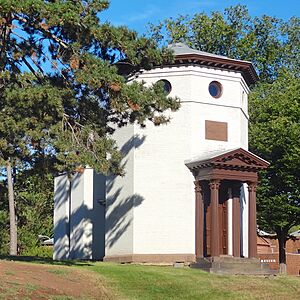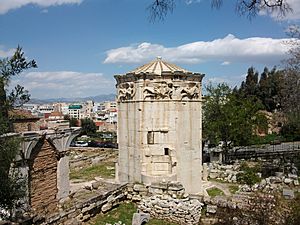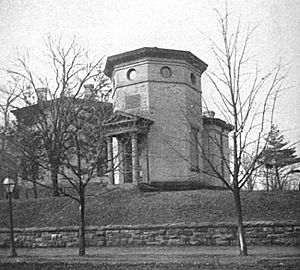Daniel S. Schanck Observatory facts for kids
The Daniel S. Schanck Observatory is a historic building at Rutgers University in New Brunswick, New Jersey, United States. It's one of the oldest observatories in the U.S., built to help students learn about the stars and planets. You can find it on George Street, near the university's old Queens Campus.
This two-story observatory was designed by architect Willard Smith. He based its look on the ancient Tower of the Winds in Athens, Greece, which is super old, from about 50 BC! Construction started in 1865 and finished in 1866. It was named after Daniel S. Schanck, a businessman from New York City, who gave a lot of money to build and equip it.
The observatory was filled with telescopes, clocks, and other science tools. It was the first building at Rutgers dedicated to science. For many years, from the mid-1800s to the late 1900s, students used it to study astronomy.
Because it's so old and important, the Schanck Observatory was added to the New Jersey Register of Historic Places and the National Register of Historic Places in 1973. It was last used for teaching astronomy in 1979. The building was fixed up in 2016. Its main telescope, a 150-mm (6-inch) telescope made in Paris, was also restored between 2016 and 2018. Now, on special days like Rutgers Day, you can take tours to see this historic observatory and its old telescope.
Why Was the Observatory Built?
In 1864, Rutgers College became New Jersey's special "land-grant" college. This meant it received money from the government to teach subjects like engineering, science, farming, and military studies. Before this, Rutgers mostly taught classic subjects like history and literature.
David Murray, a professor of math and astronomy, suggested building an observatory. He thought it would be great for the college's new focus on science. This observatory would be the fourth building at Rutgers and the very first one built just for science!
The observatory cost about $6,166 to build and equip. Daniel S. Schanck, a New York City businessman, donated $2,400 of that money. He wasn't a Rutgers graduate, but friends of the college convinced him to help. Years later, his son even studied science at Rutgers.
How Was It Designed and Used?
In 1865, the college hired architect Willard Smith. He designed a small, two-story, eight-sided building. It looked like the Tower of the Winds in Athens, Greece, an ancient building that once held a water clock and sundial.
The observatory was made of painted brick with wooden details. It had a small entrance porch with columns, like an ancient Greek temple. Inside, Rutgers put in a 6.5-inch refracting telescope (a type of telescope that uses lenses). They also added a special telescope for observing stars as they crossed the sky, a sidereal clock (which measures time based on stars), a mean solar clock (which measures time based on the sun), and other tools. Some of this equipment was given by people and by the college's student societies.
The Schanck Observatory was officially opened on June 18, 1866. A famous lawyer and future Supreme Court Justice, Joseph P. Bradley, gave a speech. The observatory was very good at telling time accurately by watching the sun.
Over the years, the observatory was used, then sometimes neglected. It wasn't used much before 1960. But then, a professor named Maurice Bazin helped bring it back to life. Students in the Rutgers Astronomical Society used it from 1968 to 1976. It was last used for teaching students between 1976 and 1979.
Today, Rutgers has a more modern observatory called the Robert A. Schommer Astronomical Observatory. It's on the roof of the Serin Physics Laboratory on the Busch Campus and has a larger telescope installed in 1996.
The Schanck Observatory is one of the oldest buildings on Rutgers' Queens Campus. Because of its history, it was listed on the New Jersey Register of Historic Places and the National Register of Historic Places in 1973.
The building needed repairs after some parts of the telescope were stolen. A company called Wu & Associates fixed up the observatory building in 2012.




